19th-placed Monaco faced Marseille who were in good form in the fifth matchday of Ligue 1 on Sunday. Monaco have not had a single victory yet in their hands with two draws and two losses earned in four matches. Marseille, meanwhile, have been doing a fairly good job as of late, winning two matches while drawing and losing once respectively.
Almost getting relegated last season after finishing in a 17th-place in the Ligue 1 table, the arrival of Leonardo Jardim was expected to restore the Monegasque club and bring them back to the upper-side of the table where they belong. However, their terrible performances and unpleasing results have surprisingly continued onto this season and unsurprisingly, they earned yet another loss in the league, making them winless in five games already. On the other side of the pitch though, the results put the side that are currently managed by Andres Villas-Boas in fourth place with 10 points, overtaking Lille in the process.
In this tactical analysis, we’ll be taking a closer look at how both teams performed and what kind of tactics did they set up for the game.
Lineups
Monaco (4-4-2)
Having used a 3-5-2 system in their last match, Monaco reverted to using a 4-4-2 in this match. The strikeforce of Wissam Ben Yedder and Islam Slimani was yet again on display in this match after the two strikers playing very well in their last match against Strasbourg with the latter scoring two in that game. Several changes of personnel can be seen with Benoît Badiashile, Adrien Silva, and Gil Dias all relegated to the bench while Ruben Aguilar, Tiémoué Bakayoko, and Cesc Fàbregas saw their names in the starting lineup in this game.
Starting XI: Lecomte – Aguilar, Glik, Maripán, Ballo-Touré – Martins, Fábregas, Bakayoko, Golovin – Ben Yedder, Slimani
Bench: Benaglio, Badiashile, Silva, Augustin, Keita, Dias, Onyekuru
Coach: Leonardo Jardim
Marseille (4-3-3)
Villas-Boas deployed his team in his favourite system which is 4-3-3 in this match. They were playing with a rather flexible, fluid, and a fairly high-intensity system where players would actively rotate their position whilst also rotating the ball in a fairly quick tempo and keeping possession. Didn’t seem to be a lot of differences than the way they play in their last game against Saint-Étienne.
Only one change of personnel in this game for Marseille with Valère Germain coming into the starting 11 to replace Hiroki Sakai. Bouna Sarr, meanwhile, was played in a deeper position as a right-back while Germain filled in at right-wing.
Starting XI: Mandanda – Sarr, Kamara, González, Amavi – Strootman, Lopez, Sanson – German, Benedetto, Payet
Bench: Pelé, Ćaleta-Car, Chabrolle, Khaoui, Rongier, Aké, Radonjić
Coach: André Villas-Boas
A balanced affair
Both teams showed their attacking intent since the start of the game. Marseille seemed to be the ones who were more dangerous though as they managed to get into dangerous areas several times already in the first 10 minutes of the game while Monaco were struggling to find their rhythm
Monaco seemed to build their play up from the back. They moved the ball in a moderate tempo, not very quick but not exactly slow either. They seemed to try to break through the flanks when in the attacking phase albeit seemingly trying to progress the ball through the middle at first in the build-up. However, due to Marseille’s compact and narrow defence and extremely crowded middle, Monaco were often forced to play and progress through the flanks.
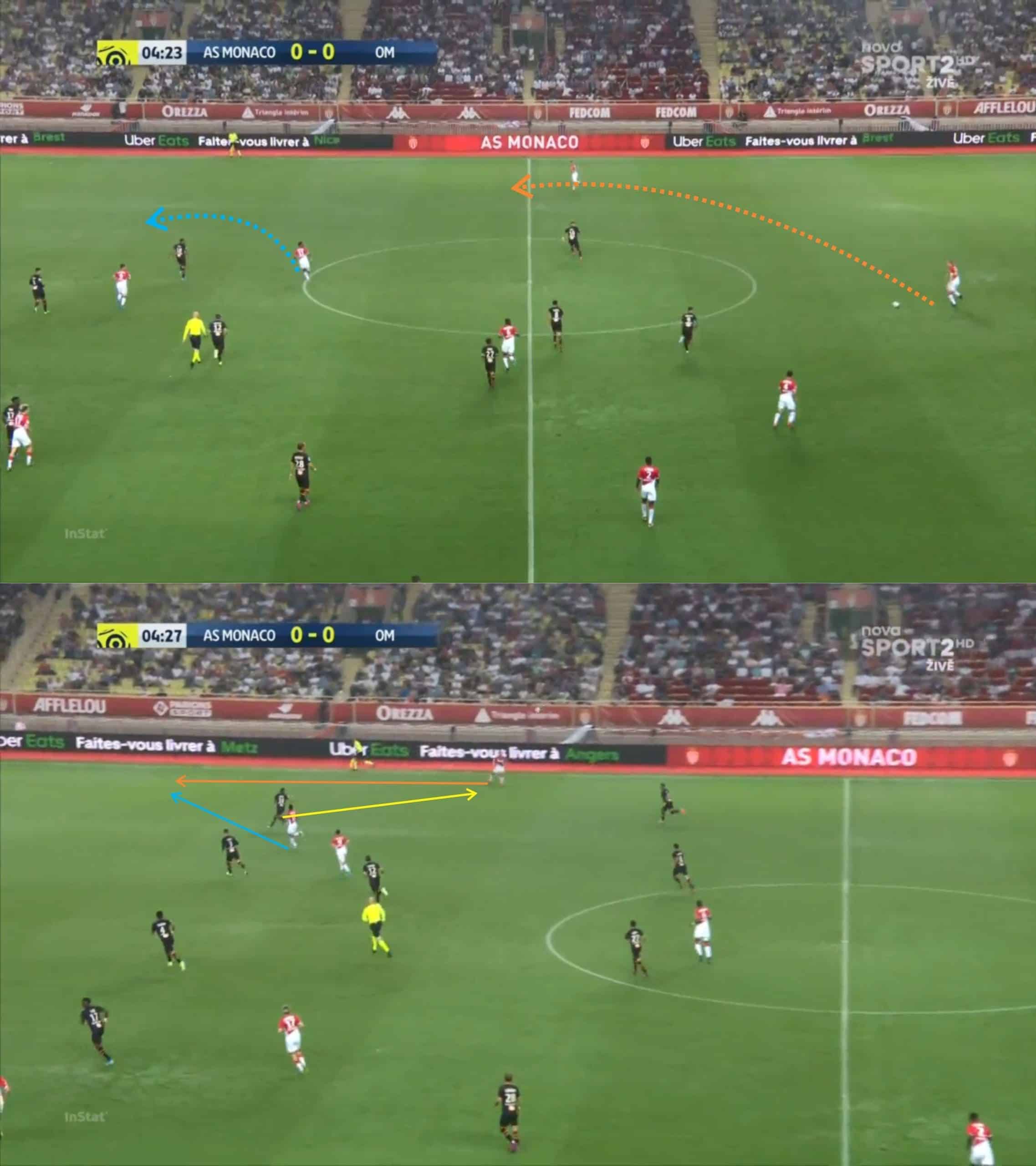
The picture above is a good example of how Monaco tended to play when they have the ball. As mentioned before, they tended to play the ball out from the back, not rushing to go forward. They moved the ball a lot laterally, trying to find the gap through to play the ball through and progress forward. With Monaco having the full-backs sit high and wide to stretch Marseille’s defence while the winger sat narrow in the half-space while occupying the full-back, they often tried to catch them off guard by switching the play quickly, knowing that due to Marseille’s defensive tactics which were to compress space and concentrate players on one side of the pitch, there should be a good amount of space left on the other side of the pitch that could be exploited if they could move the ball and switch the play quickly.
In the picture above, Kamil Glik received the ball with the instep of his back foot from Maripán and quickly turning to shape himself up to distribute the ball into space in the right flank. With Dimitri Payet sitting quite high and narrow and Ruben Aguilar sitting rather high and wide, the latter was effectively free from any opposing player in that area. When the ball was played towards Aguilar, Gelson Martins has already prepared his outward run towards the right flank from the half-space and Jordan Amavi followed him. Amavi saw the opportunity to challenge Aguilar and take the ball away from him as the latter seemed to be a bit uncomfortable when controlling the ball, leaving the blisteringly pacey Martins free at the back as he continues his run behind the Marseille left-back. Aguilar then managed to release a through pass onto the path of Martins who was completely free out wide and delivered the ball low into the box. However, the cross wasn’t perfect and was easily cut out by Marseille’s defender.
There were some differences in tendencies between Alexandr Golovin and Martins though.
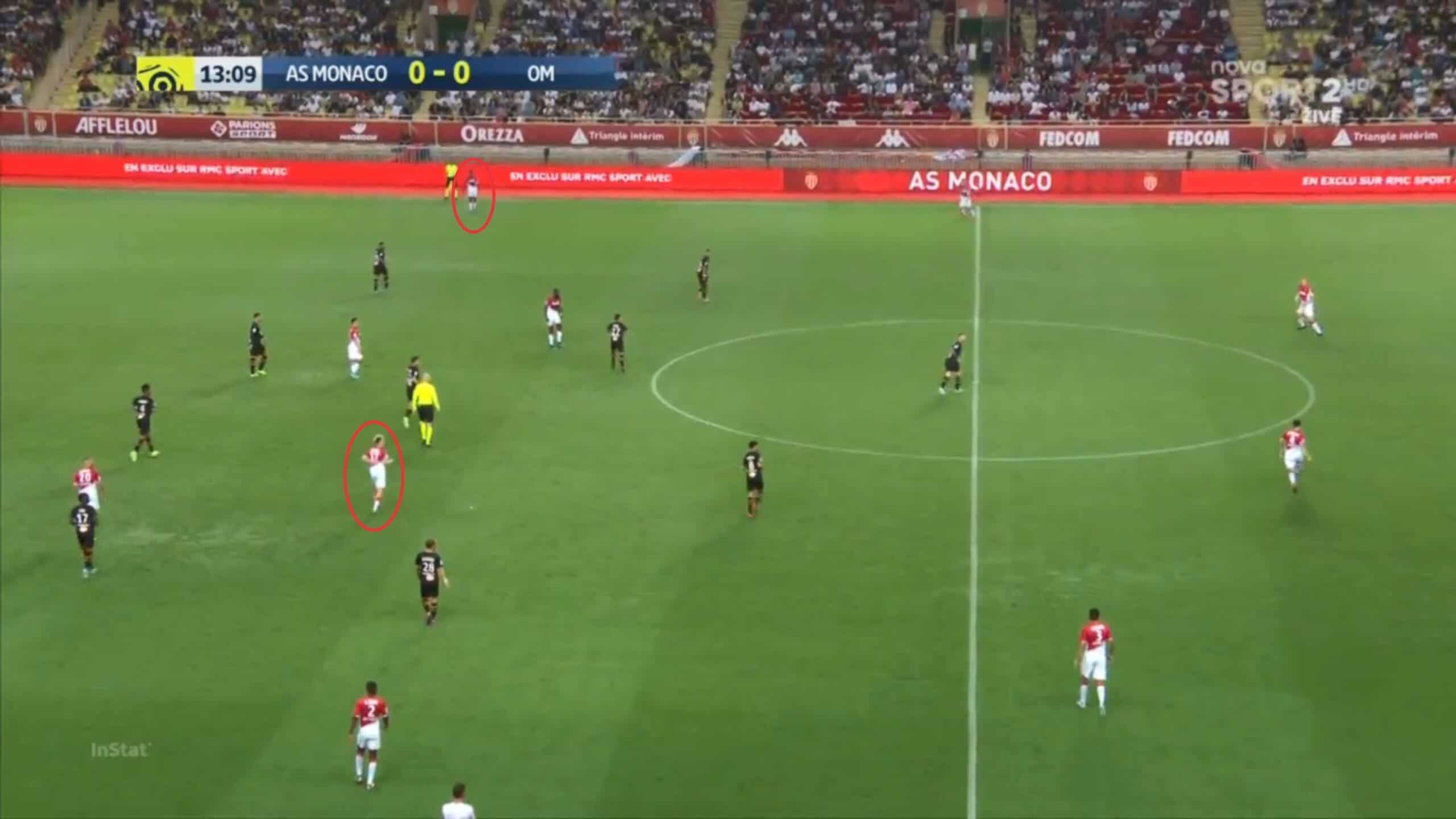
While the latter preferred playing wider and closer to the touchline, making outward runs from the half-space and storming down the flank before delivering a cross, the former tended to play centrally, making inward runs from out wide or just sitting in the half-space most of the time throughout the game, letting Fodé Ballo-Touré do the job in the wider areas, and at certain times trying to exploit the space left by Boubacar Kamara if the young centre-back followed Slimani wide, rendering him out of position.
Monaco tended to break quickly in their attacking transitions. A lot of times, they can be seen using long passes onto the foot or into space from the back with Fàbregas being the main distributor. Some other times the ball was given to either Ben Yedder, Golovin, or Martins, all of who tended to attempt progress the ball through the dribbling before executing their next attacking action which was either a through pass or a direct shot at goal.
Having two strikers who are extremely good at finishing chances, Monaco were very dangerous when they managed to work their way up and get a chance to deliver the ball into the box. Indeed, Monaco tended to pump the ball in either from the byline or from deep, usually from wider areas rather than central though. This was a bit different than their opponents who were able to work their way up into the box where they could deliver a cut-back cross or take a shot directly at goal. We’ll talk about that later in this tactical analysis.
Facing that kind of attacking approach from Monaco, Marseille had to defend well from high up the pitch and prevent the hosts from being able to even progress the ball, let alone having time and space in dangerous areas where they could deliver the ball into the box.
Villas-Boas’ side set up a medium-high defensive block in the shape of 4-1-4-1. As mentioned before in this tactical analysis, they were very compact and narrow in defence, concentrating the players on one side of the pitch to create an overload.
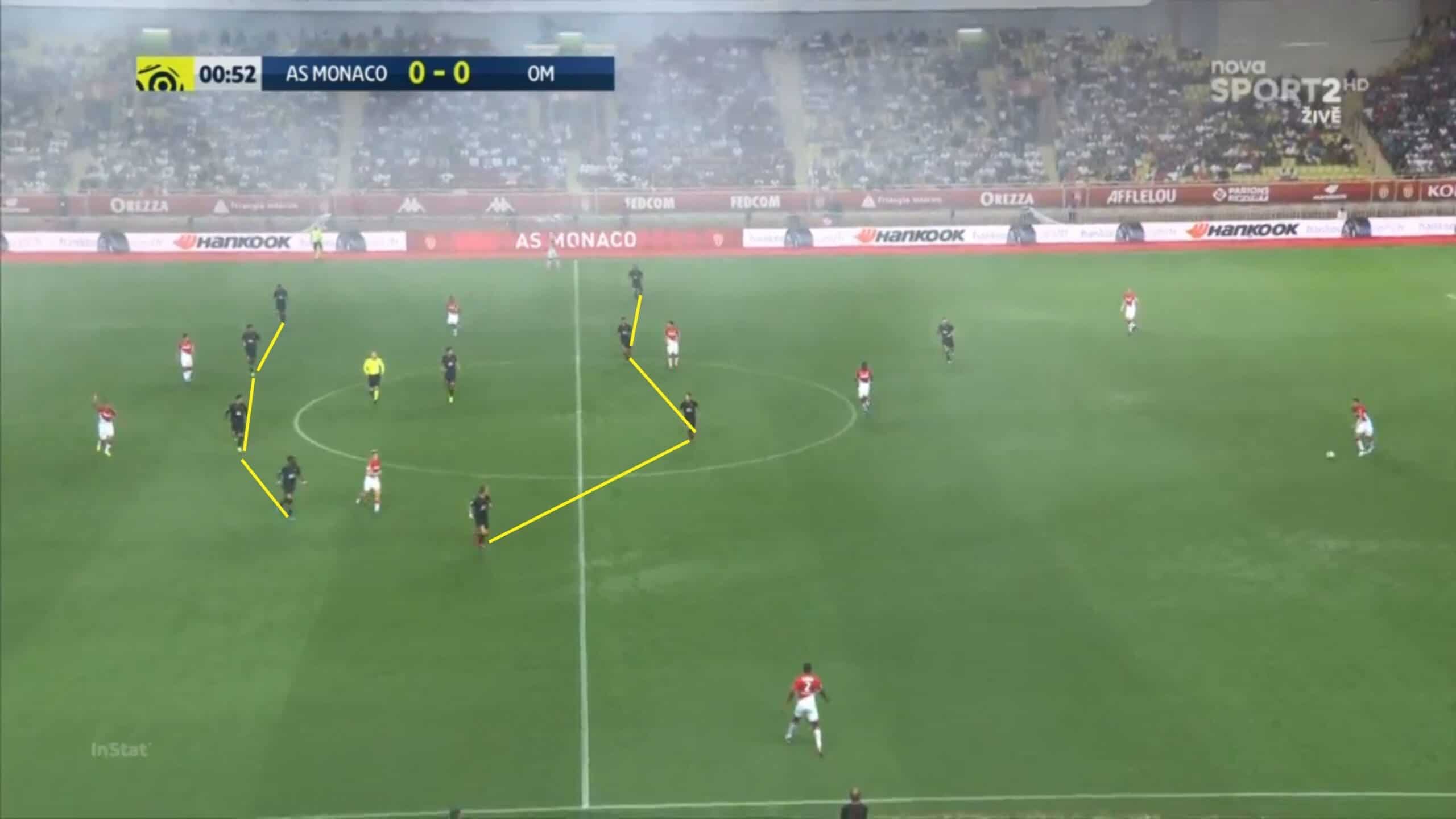
The picture above showed Marseille’s defensive organisation. The striker, Darío Benedetto aimed to close down the ball-carrier, split the two centre-backs, block the ball carrier’s passing lane to his centre-back partner, and push him to move the ball to the flank where Marseille would then execute their pressing trap and create an overload to isolate the ball-carrier once the ball was played to the flank.
As you can also see in the picture above, the two central midfielders of Monaco were often marked and followed, making it very difficult and very risky for the centre-back to play the ball there while Germain was already preparing to press Ball-Touré if the ball was played towards him. Midway through the first half though, Fàbregas understood what was happening and decided to drop deeper often, positioning himself in between the two centre-backs to help the build-up play whilst also making it a bit more difficult for Marseille to execute their defensive plan as Fàbregas pretty much freed himself from Morgan Sanson who certainly couldn’t follow him as it could expose the middle of the field.
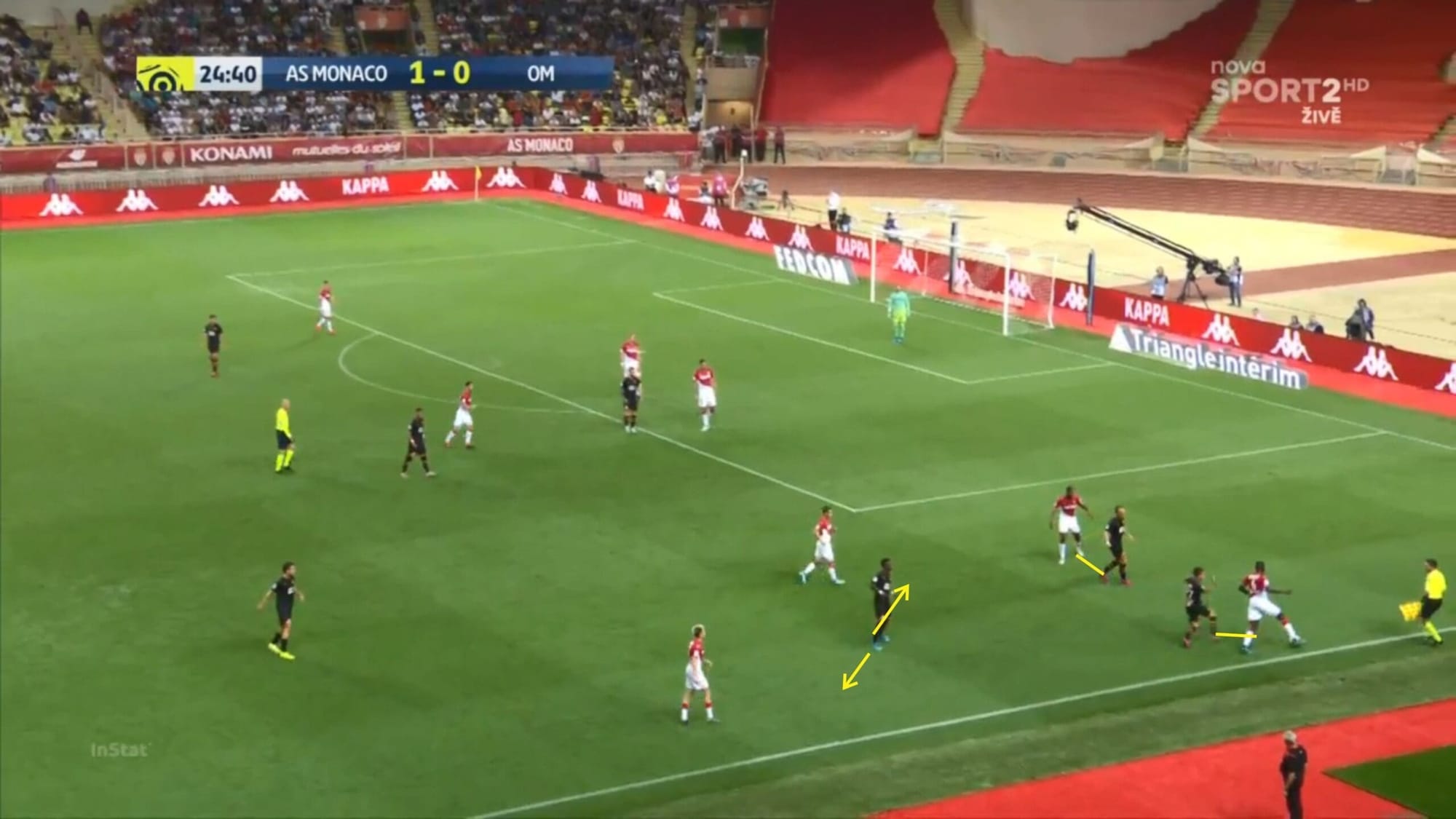
The extremely compact two banks of four with one player in between the lines made it difficult for Monaco to progress through the middle due to the lack of space and time they could get whenever the ball was there, rendering them choosing to play through the flanks and attack from there. As mentioned before though, Marseille would attempt to create an overload on the flank when the ball was played there so Monaco also didn’t have a lot of time to play on one flank and they were forced to switch the play often in order to really be able to break through the defence and hurt Marseille.
Marseille also tended to push higher up when the ball was played backwards or when Monaco seemed to be in an uncomfortable position (due to poor touch, poor pass, or a mistake from their end).
With the highly compact and narrow defence and the pressure of Marseille, Monaco needed to move the ball quicker than they’d like, causing some discomfort which is also proven in the stats with the hosts having only 43% of the possession and completing only 83% passes from 414 attempts. The guests, on the other hand, were more quite comfortable with the ball as they had 57% of the possession and completed 87% of their 540 passing attempts.
Marseille’s swift attacks
Villas-Boas’ side also tended to play in a rather quick fashion in this game. They built their play up from the back, however, due to Monaco’s high defensive block and aggressive man-oriented pressing, they were forced to move the ball and progress quickly to keep them out of the danger zone.
The home side defended with a high-blocking 4-4-2 shape and attempted to press high up the pitch in order to disrupt their opponents’ build-up play.
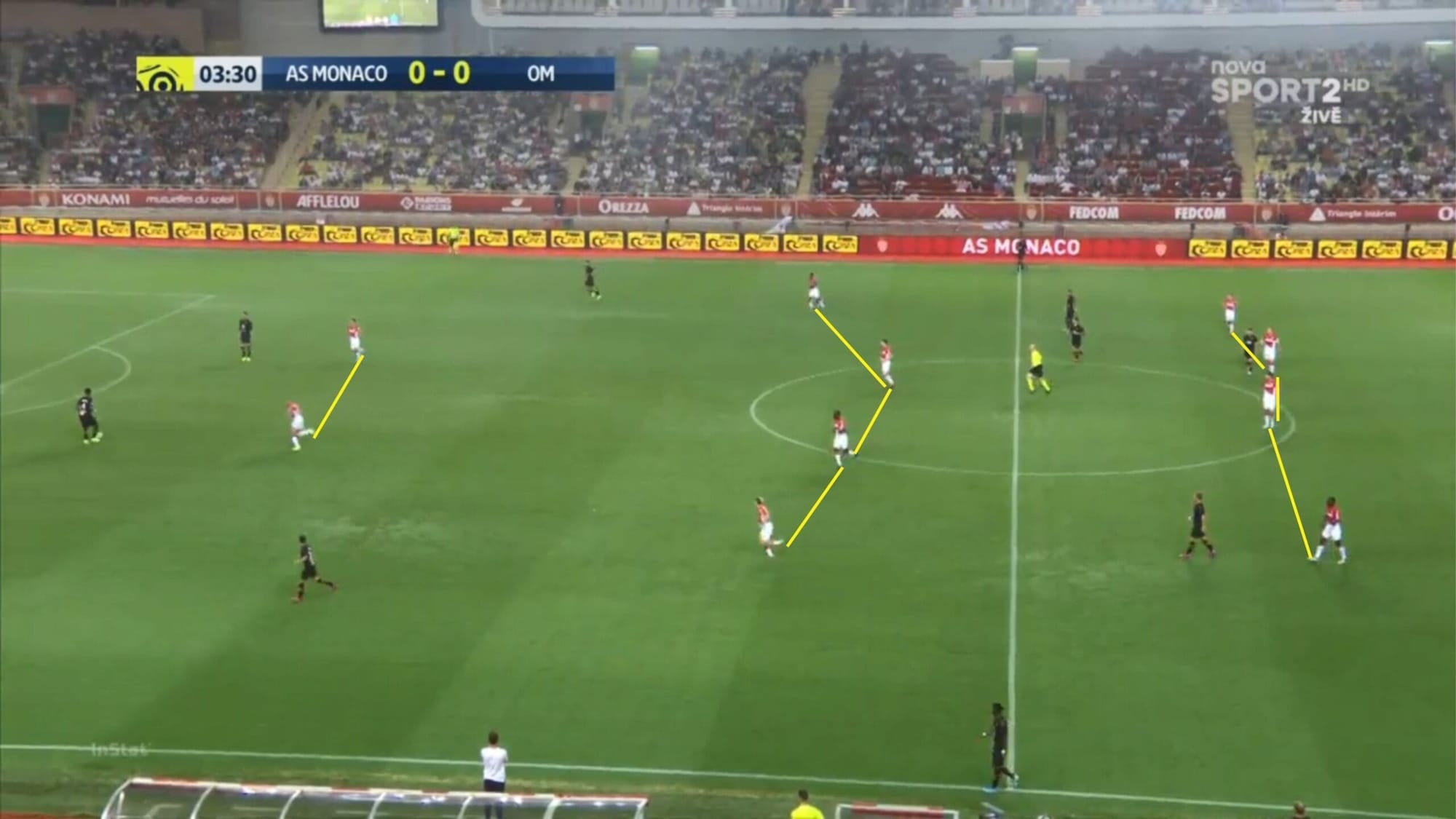
As you can see in the picture above, the two Monaco strikers would actively press the two centre-backs of Marseille, giving the ball-carrier intense pressure to force them into making a mistake. The two wingers, Martins and Golovin would keep their distance to the two full-backs of Marseille and would immediately close them down if the ball was played to them.
In order to be able to play out of the pressure, Marseille needed an extra man to play the ball to and it was usually playmaker Kevin Strootman that would sit in a pocket of space, free of any marker due to the fact that Monaco’s two central midfielders were already occupied by two of Marseille’s central midfielders, making them decide not to push up and mark Strootman. Meanwhile, due to the two strikers tending to mark and press the two centre-backs, Strootman was often left completely free, making it rather easy for Marseille to escape the pressure. Not just Strootman, Sanson and Maxime Lopez also often dropped deeper and positioned themselves in a pocket of space whenever needed to help his teammates at the back exit the pressure from Monaco.
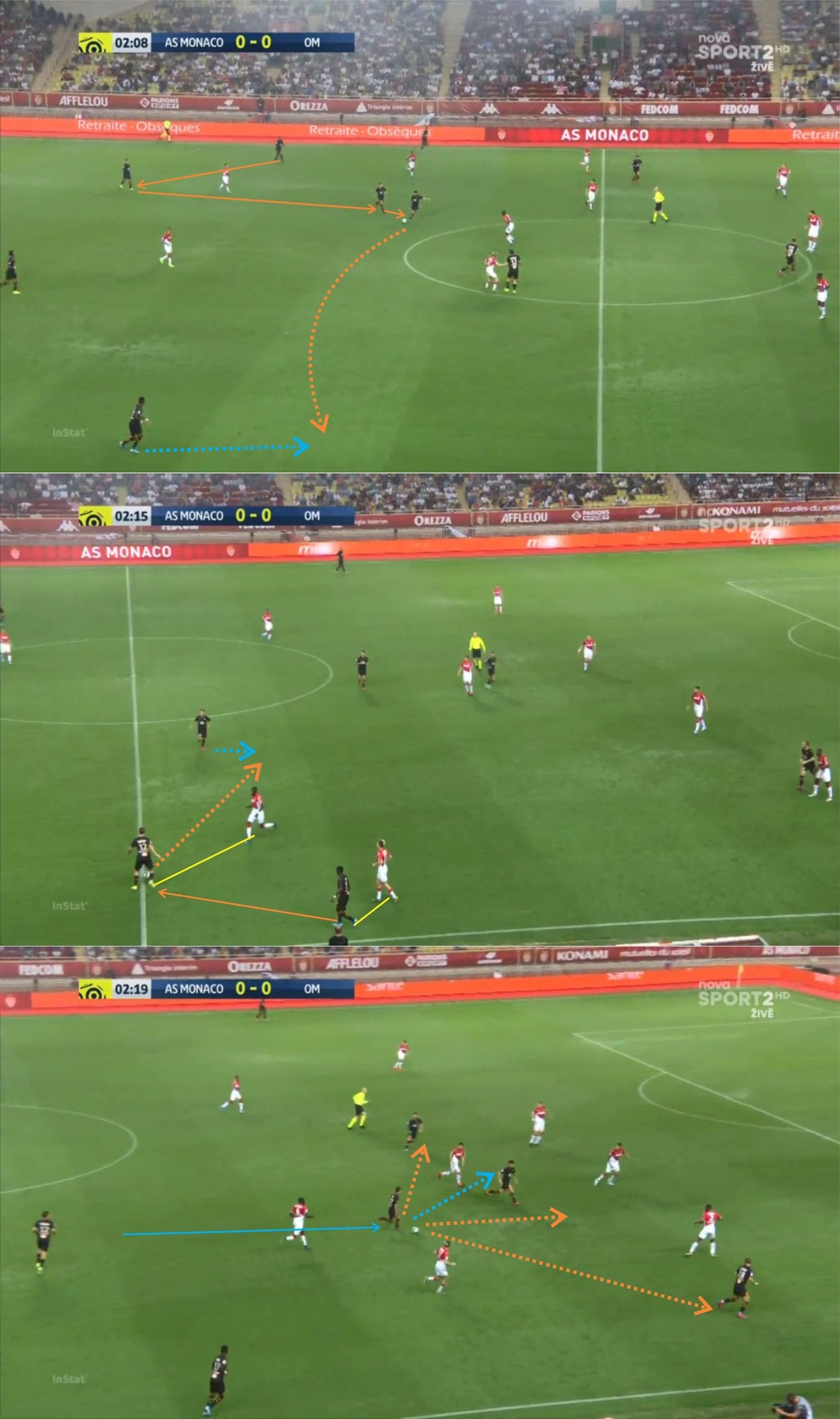
The difference between Monaco and Marseille was that while Monaco were only able to hit and hurt Marseille through the flanks due to their compactness and crowded middle, Marseille were able to pose threats from pretty much anywhere on the pitch.
As you can see in the picture above, Monaco also defended narrowly and concentrated players on one side of the field, although with a different approach of man-oriented marking and pressing as mentioned several times already in this tactical analysis. Due to this, Marseille were able to attack them by exploiting spaces in wider areas by switching the play quickly. In the situation above, Marseille successfully escaped pressure after Álvaro González played the ball to Sanson who then continued the ball to Lopez. The young centre-mid then moved it wide to the right flank where Sarr was present.
Monaco started moving their block and were focusing on their left-hand side of the pitch now, however, the blocked seemed to move a bit too slow which was an advantage for Marseille as they managed to create a situation where they were numerically superior on that side of the pitch while the Monaco players were still getting into position. In the second picture above, Sarr moved the ball back to Strootman who was immediately closed down by Bakayoko, but easily played the ball past the former Rennes midfielder by passing it through to Lopez.
As you can see in the third picture above, Lopez then dribbled forward freely without any direct opponents disturbing him with Bakayoko only jogging back, seemingly uninterested to win back the ball and Fàbregas seemingly unsure whether he should close him down, follow Sanson, or block his passing lane towards Benedetto who dropped from his position. Lopez had loads of option in this situation. The talented midfielder then tried to pass the ball through to Sanson, however, the pass wasn’t perfect and it was intercepted in the end.
This was a pretty consistent and visible attacking organisation by Marseille that they used in the game, although of course the patterns and the way that they executed this attacking play may vary throughout the game. They build their play up from the back, exit through the middle, progress through the half-space, and there they had the choice whether to move the ball wide for the wide players to cross the ball in, cross the ball directly from the half-space, set a player up with a through ball into the box, or cut into the player’s stronger foot and curl one into the corner of the net. All four goals of Marseille were actually the result of this brilliant attacking tactics.
Conclusion
The home team were extremely dangerous in attack, possessing the likes of Slimani, Ben Yedder, supported by the creativity of Martins, Golovin, Bakayoko, and Fàbregas along with Aguilar and Ballo-Touré who regularly bombed down the flanks to provide support and width. However, terrifying as they were in attack, their defence was disappointingly leaky. It was too easy for Marseille to play through the defence and create goalscoring chances for themselves.
Surely Monaco seemed to be in a comfortable position after leading 2-0 midway through the first half. All they had to do was protect the lead – if not by sitting deep and defending, then they could have at least try to dominate possession play more patiently and cautiously. However, that was not the case for Monaco. In fact, it was not very clear what was happening with Jardim’s side. They didn’t seem to want to lose yet again, but they also seemed reluctant to win.
For Marseille, this was a good win. A very good one, actually. And this result put them in fourth place in Ligue 1 with 10 points from five games which is not bad.
It is still early in the season though, but Marseille are looking good at the moment. They could potentially finish in a European spot again this season if they managed to keep this kind of form up. For Monaco, unless they managed to sniff out what’s wrong with the team, I highly doubt they’d even finish in the top 10.

If you love tactical analysis, then you’ll love the digital magazines from totalfootballanalysis.com – a guaranteed 100+ pages of pure tactical analysis covering topics from the Premier League, Serie A, La Liga, Bundesliga and many, many more. Buy your copy of the August issue for just ₤4.99 here.





Comments